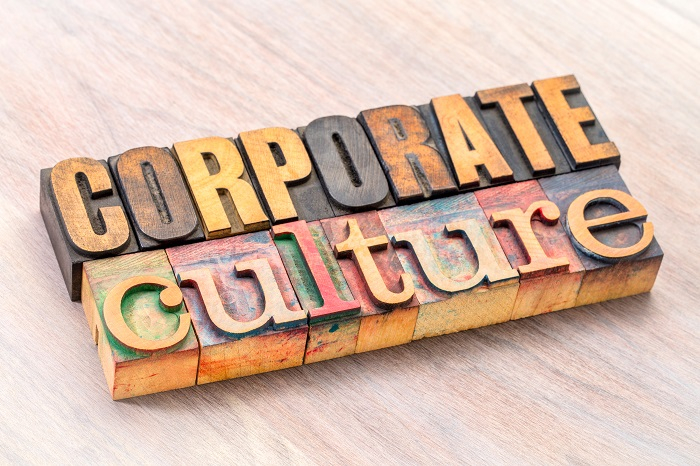
 Data Structure
Data Structure Networking
Networking RDBMS
RDBMS Operating System
Operating System Java
Java MS Excel
MS Excel iOS
iOS HTML
HTML CSS
CSS Android
Android Python
Python C Programming
C Programming C++
C++ C#
C# MongoDB
MongoDB MySQL
MySQL Javascript
Javascript PHP
PHP
- Selected Reading
- UPSC IAS Exams Notes
- Developer's Best Practices
- Questions and Answers
- Effective Resume Writing
- HR Interview Questions
- Computer Glossary
- Who is Who
Analyzing the Culture of an Organization: Competing Value Framework?
If one walked into the headquarters of Patagonia, an American company that designs gear for silent sports (climbing, surfing, or skiing), he/she would see employees wearing shorts and slippers. After work, some of the employees might go surfing. The ambiance inside the headquarter is vibrant where people work hard and have a lot of fun at the same time.
On the other side of the spectrum, if one entered the headquarters of Exxon Mobil, an American multinational oil and gas corporation, he/she would notice people with typical business attires seriously doing their work. The atmosphere exudes competitiveness and rigor.
Why is the environment of these two companies different?
It is because these two organizations have different corporate cultures.
What is Culture?
Culture is the set of beliefs and norms that all the existing employees of the organization are expected to follow and all the new hires are expected to learn. The culture of an organization is not written anywhere. Still, the employees unconsciously participate and facilitate the culture of an organization. The culture of an organization is reflected in various aspects: how the employees perform their day-to-day tasks, how the boss treats his juniors, or how the CEO reacts to an exigency.

The culture of an organization exists on two levels. The first level is the surface level which is visible to others: the way people dress, reporting structure, working space, types of equipment, rules, and regulations, number of working hours, celebrations, etc. The second level is an invisible layer of underlying values, beliefs, and assumptions that set the ground for external norms and behavior (the first level).
Let us understand these levels of culture from the above-mentioned example of Patagonia and Exxon Mobil. Patagonia endorsed the values of creativity, collaboration, and concern for the environment. Hence, the employees appeared to be in shorts and slippers. But Exxon Mobil, after the disastrous oil spill of 1989, had a more cautious approach to their operations. They established certain safety protocols which ought to be taken seriously to avoid any future mishappenings. Hence, the employees appeared serious, donning their business suits.
Role of Culture
Typically, the culture of an organization serves two purposes.
Internal Integration
The culture of the company governs the way employees interact with each other, the way they approach work, the way they communicate with each other, and the way they bond with each other at work.
External Integration
Culture also helps an organization meet its short-term and long-term goals. he way a company reacts to external demand or its competitor's moves is also defined by its culture.
The Interplay of Organization's Strategy, Environment, and Culture
An organization's culture should be in tune with the demands of the external environment, reinforcing its strategic focus. For example, if a company needs to be quick in responding to the external environment, a case true for most Internet-based companies like Twitter and Facebook, the corporate culture must endorse the values of adaptability.
On assessing the culture along two dimensions: 1. The extent of flexibility or stability demanded by the external environment and 2. The extent to which the company's strategic focus is internal or external, we get four different types of culture.

The Adaptability Culture
Being flexible and bringing change to adapt to the external environment is the core value of this culture. Companies that endorse this culture consider change inevitable and essential. These forward-thinking companies anticipate change beforehand and start working towards it. They look for employees who are open-minded, creative, innovators, risk-takers, and active problem solvers.
Example
The most prominent example of an adaptable organization has to be Amazon. Amazon began as a bookstore. With time, they have adapted to include everything under the sun: utility goods, music, movies, digital wallet, fresh fruits and vegetables, and beyond. Even today, they are adapting to changing demands because they know that bringing change is a vital part of maintaining the competitive environment.
The Mission Culture
Companies with this culture have clearly defined goals like maintaining market share, achieving sales growth, or increasing profitability. All the employees are expected to work towards this common goal and are rewarded suitably. Hence, the environment of these companies is quite stable. The employees are motivated by envisioning the future.
Example
Since Byjus entered the Ed-tech industry, it has had a clear vision of being the market leader in the industry. All the employees are expected to be competitive and aggressive to achieve the company's goal. The top performers are rewarded handsomely. The management does not shy away from giving special treatment to these achievers.
The Clan Culture
This culture focuses on the involvement and collaboration of employees to achieve strategic goals. Companies endorsing this culture involve employees in key decisions of the organization creating a sense of responsibility and ownership in them. Hence, they are more committed to meeting the needs of the company.
Example
In 2005, HCL was struggling with a high attrition rate and a demoralized workforce. In the same year, Vineet Nayar was appointed as the president of the company. He realized that the only way to rescue the company was to introduce clan culture within the organization. He introduced a host of measures for the same. As opposed to the traditional top-down flow of ideas, he introduced the idea of a bidirectional flow of ideas, where even entry-level employees were asked for their suggestions. Opinion polls were conducted to know the take of each and every employee on important policy decisions. An online forum was created that connected the employees directly to the CEO where they could voice their concerns. All these measures pulled the company out of the turmoil and the company seemed back on track.
The Bureaucratic Culture
Bureaucratic cultures have a clear division of labor and clearly defined standard operating procedures. Companies with this culture focus on their inner strength and have a methodical approach to doing business. This culture considers consistency and conformity as paramount to success.
Hence, personal engagement is quite low here.
Example
Colleges and Universities are the best examples of bureaucratic culture. They have a fixed pedagogy following which the teacher or professors impart the knowledge. There are stringent rules which the students and the staff have to abide by.
Conclusion
The culture of an organization has a key role in shaping organizational behavior. It has a bearing on productivity and employee engagement as well. Hence, promoting the right culture, which is in line with the strategic goals, is extremely crucial for an organization. Hence an organization must periodically assess its culture and change it if needed.

